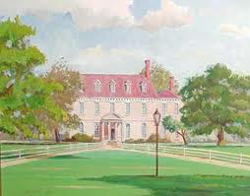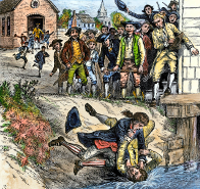The Annapolis Convention: Prelude to the Constitution
The Annapolis Convention was a gathering of concerned representatives from the various states in order to discuss ways to compensate for various difficulties that Americans were experiencing as a result of perceived Two particularly intense disagreements highlighted the ineffectiveness of the Articles:
In January 1786, Virginia Gov. Patrick Henry invited representatives of each of the 13 states to a meeting to discuss making such changes. He set as the date for the meeting the first Monday in September and the location for the meeting Annapolis, Md., which had been the capital of the new United States from November 1783 to August 1784 and the site of the ratification of the Treaty of Paris, which officially ended the Revolutionary War. Nine states designated representatives for the meeting, which came to be known as the Annapolis Convention but had the formal title of the Meeting of Commissioners to Remedy Defects of the Federal Government. The delegates from Massachusetts, New Hampshire, North Carolina, and Rhode Island did not attend because they didn't make the trip or because they arrived after the meeting had ended. Connecticut, Georgia, Maryland, and South Carolina did not send delegates. The 12 people in attendance were these:

The convention began on September 11, 1786. The first order of business was to elect a chairman; the delegates chose Dickinson. The delegates right away decided that whatever they decided would need to be forwarded to a new convention, with a representation of all the states. The delegates discussed the various concerns that had brought them to the convention, which took place in Mann's Tavern, and then tasked a committee of Benson, Clarke, Coxe, Read, and Randloph to draft a report to send to the states as whole. Hamilton helped write the report, which the committee presented on September 13. Among the recommendations was for a new convention, to take place in Philadelphia, on the second Monday of May 1787. The delegates approved the report and adjourned on September 14. The Annapolis Convention report went to Congress, which began discussing it on Oct. 11, 1786. The committee assigned to examine the report and its recommendations recommended on Feb. 21, 1787 that Congress call for a convention in Philadelphia. Congress did so. By this time, seven states had already selected the delegates that they would send to such a convention. Five other states appointed their delegates by May 1787. Only Rhode Island had not done so by this time. As well, the gathering of the Annapolis Convention and the report delivered by that convention helped convince George Washington to join the call for a stronger national government. He later wrote that "thirteen Sovereignties pulling against each other and all tugging the federal head, will soon bring ruin on the whole.? 
The Constitutional Convention began on May 25, 1787, and the result was the Constitution, which created a new form of government, with a more strong national level. The Annapolis Convention was a sort of way station between a national debate over problems with the Articles of Confederation and the full-blown Constitutional Convention. The fact that most states had sent delegates to the Annapolis Convention was a step toward unity and helped convince who had been hesitant to embrace a stronger national government to consider the possibility. |
|
Social Studies for Kids
copyright 2002–2025
David White



 weaknesses in the
weaknesses in the  Maryland and Virginia in 1785 had serious disagreements over who could benefit from commercial use of the rivers common to both states.
Maryland and Virginia in 1785 had serious disagreements over who could benefit from commercial use of the rivers common to both states.
